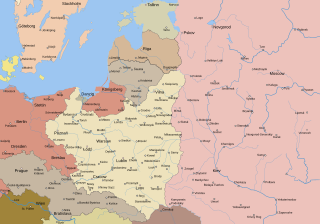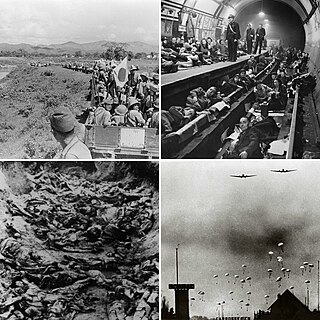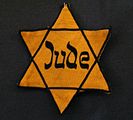
Nazi Germany used six extermination camps, also called death camps, or killing centers, in Central Europe during World War II to systematically murder over 2.7 million people – mostly Jews – in the Holocaust. The victims of death camps were primarily murdered by gassing, either in permanent installations constructed for this specific purpose, or by means of gas vans. The six extermination camps were Chełmno, Belzec, Sobibor, Treblinka, Majdanek and Auschwitz-Birkenau. Extermination through labour was also used at the Auschwitz and Majdanek death camps. Millions were also murdered in concentration camps, in the Aktion T4, or directly on site.
1942 (MCMXLII) was a common year starting on Thursday of the Gregorian calendar, the 1942nd year of the Common Era (CE) and Anno Domini (AD) designations, the 942nd year of the 2nd millennium, the 42nd year of the 20th century, and the 3rd year of the 1940s decade.
1941 (MCMXLI) was a common year starting on Wednesday of the Gregorian calendar, the 1941st year of the Common Era (CE) and Anno Domini (AD) designations, the 941st year of the 2nd millennium, the 41st year of the 20th century, and the 2nd year of the 1940s decade.
1940 (MCMXL) was a leap year starting on Monday of the Gregorian calendar, the 1940th year of the Common Era (CE) and Anno Domini (AD) designations, the 940th year of the 2nd millennium, the 40th year of the 20th century, and the 1st year of the 1940s decade.

Aktion T4 was a campaign of mass murder by involuntary euthanasia in Nazi Germany. The term was first used in post-war trials against doctors who had been involved in the killings. The name T4 is an abbreviation of Tiergartenstraße 4, a street address of the Chancellery department set up in early 1940, in the Berlin borough of Tiergarten, which recruited and paid personnel associated with Aktion T4. Certain German physicians were authorised to select patients "deemed incurably sick, after most critical medical examination" and then administer to them a "mercy death". In October 1939, Adolf Hitler signed a "euthanasia note", backdated to 1 September 1939, which authorised his physician Karl Brandt and Reichsleiter Philipp Bouhler to begin the killing.

Viktor Hermann Brack was a member of the Schutzstaffel (SS) and a convicted Nazi war criminal and one of the prominent organisers of the involuntary euthanasia programme Aktion T4; this Nazi initiative resulted in the systematic murder of 275,000 to 300,000 disabled people. He held various positions of responsibility in Hitler's Chancellery in Berlin. Following his role in the T4 programme, Brack was one of the men identified as responsible for the gassing of Jews in extermination camps, having conferred with Odilo Globočnik about its use in the practical implementation of the Final Solution. Brack was sentenced to death in 1947 in the Doctors' Trial and executed by hanging in 1948.

Philipp Bouhler was a German senior Nazi Party functionary who was both a Reichsleiter and Chief of the Chancellery of the Führer of the NSDAP. He was also the SS official responsible for the Aktion T4 euthanasia program that killed more than 250,000 disabled adults and children in Nazi Germany, as well as co-initiator of Aktion 14f13, also called Sonderbehandlung, that killed 15,000–20,000 concentration camp prisoners.

The military occupation of Latvia by Nazi Germany was completed on July 10, 1941, by Germany's armed forces. Initially, the territory of Latvia was under the military administration of Army Group North, but on 25 July 1941, Latvia was incorporated as Generalbezirk Lettland, subordinated to Reichskommissariat Ostland, an administrative subdivision of Nazi Germany. Anyone not racially acceptable or who opposed the German occupation, as well as those who had cooperated with the Soviet Union, was killed or sent to concentration camps in accordance with the Nazi Generalplan Ost.

After the occupation of Latvia by the USSR in June 1940, much of the previous Latvian army was disbanded and many of its soldiers and officers were arrested and imprisoned or executed. The following year Nazi Germany occupied Latvia during the offensive of Army Group North. The German Einsatzgruppen were aided by a group known as Arajs Kommando in the killing of Latvian Jews as part of the Holocaust. Latvian soldiers fought on both sides of the conflict against their will, and in 1943 180,000 Latvian men were drafted into the Latvian Legion of the Waffen-SS and other German auxiliary forces.
Holocaust victims were people targeted by the government of Nazi Germany based on their ethnicity, religion, political beliefs, disability or sexual orientation. The institutionalized practice by the Nazis of singling out and persecuting people resulted in the Holocaust, which began with legalized social discrimination against specific groups, involuntary hospitalization, euthanasia, and forced sterilization of persons considered physically or mentally unfit for society. The vast majority of the Nazi regime's victims were Jews, Sinti-Roma peoples, and Slavs but victims also encompassed people identified as social outsiders in the Nazi worldview, such as homosexuals, and political enemies. Nazi persecution escalated during World War II and included: non-judicial incarceration, confiscation of property, forced labor, sexual slavery, death through overwork, human experimentation, undernourishment, and execution through a variety of methods. For specified groups like the Jews, genocide was the Nazis' primary goal.

After the German invasion of the Soviet Union, the Baltic states were under military occupation by Nazi Germany from 1941 to 1944. Initially, many Estonians, Latvians, and Lithuanians considered the Germans liberators from the Soviet Union.

This is a timeline of World War II events that took place in 1940, the first full year of the second global war of the 20th century.

This is a timeline of events that stretched over the period of World War II in 1941, marked also by the beginning of Operation Barbarossa on the Eastern Front.
Events in the year 1939 in Germany.
Events in the year 1940 in Germany.
Events in the year 1942 in Germany.
Events in the year 1943 in Germany.
Events in the year 1944 in Germany.
Events in the year 1945 in Germany.
The following events occurred in October 1941:













